Rockchip RK3328 is a new TV box SoC competing with Amlogic S905(X) TV boxes thanks to its quad core Cortex A53 processor, Mali-450MP GPU, HDMI 2.0a, and its 4K VPU with HDR support. We’ve already seen a few products launched with the processor such as A5X Plus, and T98 4K Ultra HD TV boxes, but I’ve only just received my first RK3328 TV box – courtesy of GearBest – with A95X R2 model. In the first part of the review, I’ll go through the specifications, and check out the devices, and the hardware design, before testing the firmware in several weeks.
A95X R2 TV Box Specifications
- SoC – Rockchip RK3328 quad core Cortex A53 processor @ 1.5 GHz with Mali-450MP2 GPU
- System Memory – 1GB RAM
- Storage – 8 GB eMMC flash + micro SD card
- Video Output – HDMI 2.0a up to 4K @ 60 Hz with HDR10 and HLG support, 3.5mm AV port (composite)
- Video Codec – 4K VP9, H.265 and H.264. 1080p VC-1, MPEG-1/2/4, VP6/8
- Audio – Via HDMI, AV port (stereo audio), and 3.5mm coaxial S/PDIF jack
- Connectivity – 10/100M Ethernet, 802.11 b/g/n WiFi (RTL8189 module)
- USB – 2x USB 2.0 port, 1x USB 3.0 port
- Misc – IR receiver, power button, front panel LED display
- Power Supply – 5V/2A
- Dimensions – 9.50 x 9.50 x 1.50 cm
- Weight – 120 grams
There’s no Bluetooth, and the box runs Android 7.1.1.
A95X R2 TV Box Unboxing
I reeived the box in its retail package marked “A95X R2 Android TV Box”.
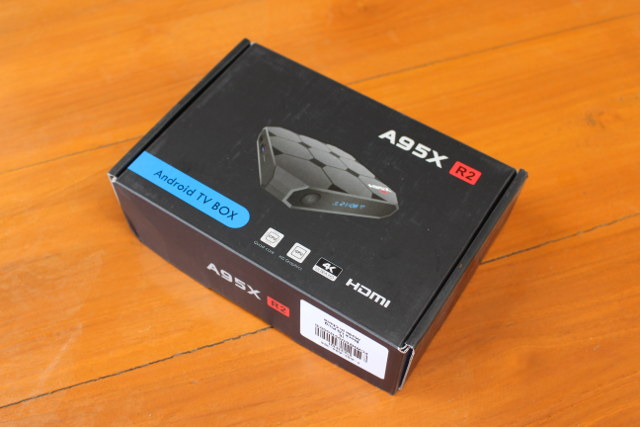
The nice looking device comes with an IR remote control with IR learning function, a HDMI cable, a 5V/2A power supply (which may be an issue with USB 3.0 HDD?), and a very basic user’s manual in English.
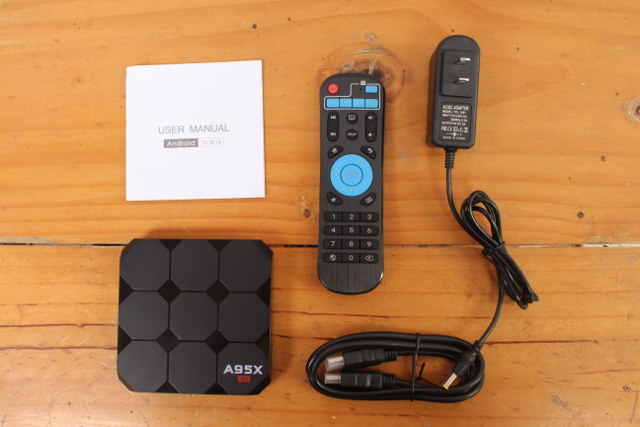
All fours sides of the device are used:
- Front panel – Power button, IR receiver windows, and LED display
- Side 1 – USB 2.0 port, USB 3.0 port, and micro SD card
- Rear panel – Coaxial S/PDIG, Ethernet, AV port, HDMI port, and DC jack
- Side 1 – USB 2.0 port
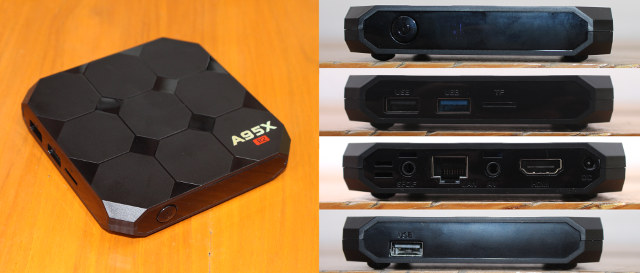
A95X R2 TV Box Teardown
Opening the device is pretty easy. Take out the rubber pads, and loosen the three screws underneath as one of the pad locations do not come with a screw.
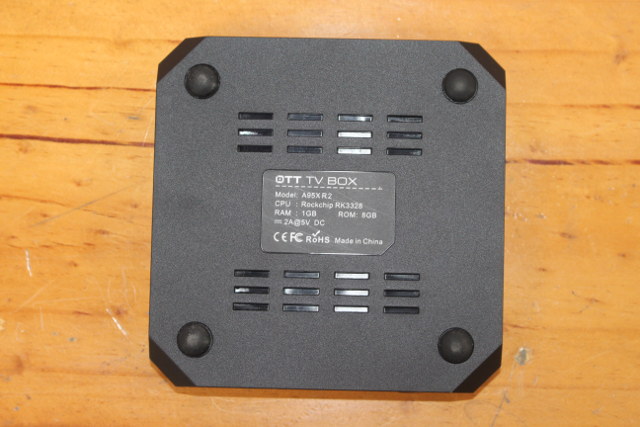 Now use a sharp and rigid plastic tool to pop out the top cover.
Now use a sharp and rigid plastic tool to pop out the top cover.
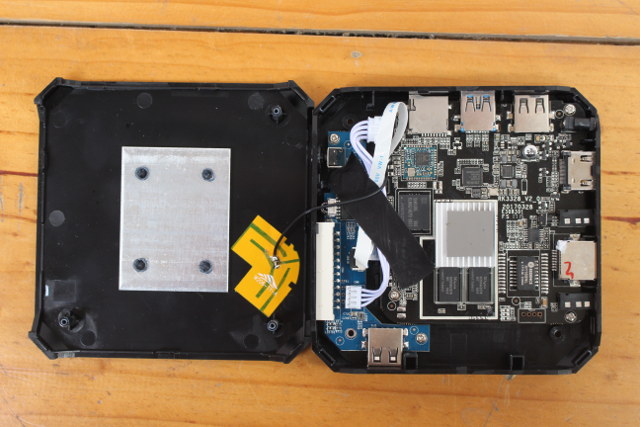
We can see there are two boards with the main board, and the board for the front panel and one USB ports. Cooling is achieved with a heatsink on RK3328 SoC, a thermal pad touching another thick metal plate.
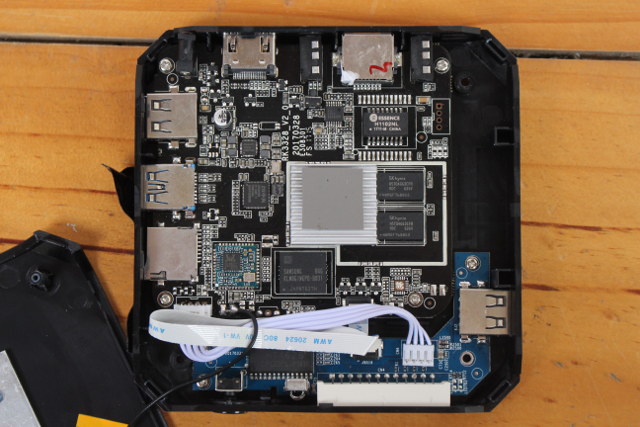
Rockchip RK3328 is connected to a low end 8GB Samsung KLM8G1WEPD-B031 eMMC 5.0 flash (140/8 MB/s R/W speed, 5K/0.6K IOPS), and two SKHynix H5TQ4G63CFR DDR3 chips (1GB RAM). Ethernet is implemented through ZTE ZX2AA500 Gigabit Ethernet transceiver – also found in Yundoo Y8, and Essence H1102NL Fast Ethernet magnetics leading to a 10/100M Ethernet interface. It seems crazy to mix a Gigabit Ethernet transceiver with a Fast Ethernet transformer, but that’s what we have here. Maybe they had a large stock of the latter… Realtek RTL8189ETV is used for 802.11 b/g/n WiFi.
Other ICs on RK3328_V2_0 board include Rockchip RK805-1 PMIC and DIO2133 stereo audio driver, while the front panel board is equipped with Holtek HT1628 LCD controller driver. The recovery button is placed right behind the AV port, and we can see a 4-pin header on the top right, which must be the serial console. There’s virtually no community development around RK3328 processor right now (AFAIK), but this may change soon, as Pine64 will shortly release ROCK64 board powered the processor.
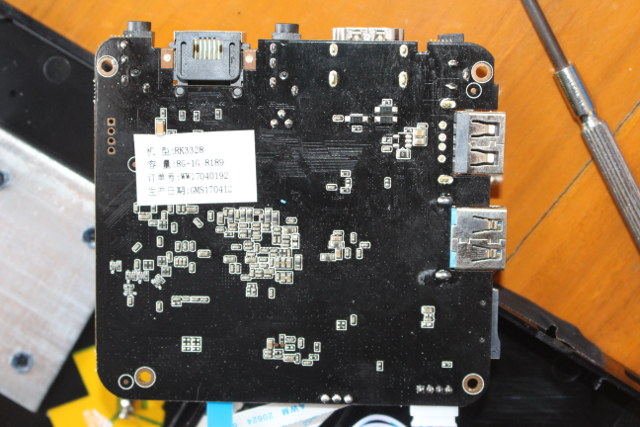 There’s basically nothing to see on the back side, except a sticker with the key specs: RK3328 / 8G-1G-8189….
There’s basically nothing to see on the back side, except a sticker with the key specs: RK3328 / 8G-1G-8189….
I’d like to thank GearBest for sending a review sample, and if you are interested you can purchase A95X R2 TV box for $35.99 including shipping on their website [Update: Use GBA95XR2 coupon to bring the price down to $32.99]. You’ll also find the 4K TV box on Banggood, GeekBuying, and Aliexpress for around $40.
Continue reading A95X R2 TV Box Review – Part 2: Android 7.1, Video & Audio Tests, and Benchmarks

Jean-Luc started CNX Software in 2010 as a part-time endeavor, before quitting his job as a software engineering manager, and starting to write daily news, and reviews full time later in 2011.
Support CNX Software! Donate via cryptocurrencies, become a Patron on Patreon, or purchase goods on Amazon or Aliexpress





LOL, the 3rd RK3328 based TV box and all are limited to Fast Ethernet (meanwhile in Pine64 IRC rumours about Gigabit Ethernet issues with Rock64 prototypes 😉 )
RK3328 based MX9 PRO and Z28 also have only Fast Ethernet according to Gearbest while only Z28 Pro features Gigabit Ethernet (and non-crappy Wi-Fi 🙂 ) Well, the target audience won’t care about network speeds but I find this interesting. Let’s see how Rock64 will perform.
@tkaiser
The crazy part is that the board comes with a Gigabit Ethernet transceiver, so it should be connected to the RGMII interface of the processor, but then they appear to use a Fast Ethernet transformer.
They could have either saved one chip by using the Ethernet PHY inside the processor, or upgraded to Gigabit by using a proper transformer, which should not be that much more expensive.
@cnxsoft
According to your picture instead of the H1102NL a larger 24-pin 1000Base-T transformer could also be used.
So maybe this is just a ‘fix’ for Gigabit Ethernet issues (I had to learn half a year ago over at Pine64 forums that average users are happy to cripple Ethernet cables to ‘downgrade’ to stable 100 MBits/sec instead of suffering from way lower speeds due to the Gigabit Ethernet PHY issues some Pine64+ were affected from).
Or maybe Rockchip’s RK3328 reference design knows only ZX2AA500 for now? At least we had/have such a situation with Allwinner H3 TV boxes but the other way around: SoC supports Gigabit Ethernet but Allwinner’s smelly BSP does not, that’s why there is not a single TV box out there with GbE.
Can you buy the remote separately? Looks like a good remote.
Rock64 will use RTL8211E as GbE PHY instead: http://kaiser-edv.de/tmp/NumpU5/ROCK64_Schematic_v1.0_20170602_cropped.pdf
You can find people working on bringing LibreELEC to these boxes: https://github.com/Kwiboo/LibreELEC.tv/tree/rockchip/projects/Rockchip/devices/RK3328
This chip rocks.
Can play any format 4k 60fps and hdr without any glitch.
No skip frames , no shutter.
Using RKMC.
Alo has auto frame rate that works.
Just waiting the next part(s)!
I really was looking some good REVIEW about this device!
@cnxsoft Could you elaborate on the learning function of the remote? Also, how do you tell if a given remote has it or not? TIA
@Henrique if it’s the same as my Nexbox A95 (S905X) box, and it does look the same, then you can program the 5 blue buttons at the top of the remote by holding down some button for 20 seconds, and then pointing your existing remote at this one while activating the desired function. I only ever used it for the power control on my TV, and it worked OK. I hated the remote in general (particularly the mouse function) so I use a Probox2 Remote+ which is far better (although it doesn’t do learning).
@roel
That remote is pretty common, but I can’t find it for sale separately.
@Henrique
Just like @RobBrownNZ said. Plus the instructions are written on the back of the remote.
@cnxsoft
If they will come with a gigabit Ethernet upgrade and linux comes to this device (Armbian?) and your review is positive, then I will definitely buy this box.
Hope they have Gigabit Ethernet then I will buy it
CNX
Do you know how the GPU is configured? Amlogic s905 have a penta ( five core GPU if I understand right ). How is the RK3328 450MP2 configured?
@theguyuk
I think it works like this:
Amlogic S905 – Mali-450MP3 2+3 core GPU
Rockchip RK3328 – Mali-450MP2 2+2 core GPU
So maybe some games will play a little better on S905.
@roel
Why would developers waste time with TV boxes without schematics and vendor support? Especially if there’s something like this available: http://kaiser-edv.de/tmp/NumpU5/ROCK64_vs_RPi_3.jpg (same SoC, Gigabit Ethernet, 1 x USB3, 2 x USB2, up to 4 GB DRAM, socketed eMMC)
@tkaiser
TV boxes are cheaper than development boards for several use cases such as media player or game emulator.
Taking Allwinner H3 as example, some people may prefer to use Beelink X2 instead of Orange Pi/NanoPi boards since the case, power supply, HDMI cable, and remote control are included.
It’s supported by Armbian too: https://www.armbian.com/beelinkx2/
@cnxsoft
Hardkernel folks write wrt S905 GPU: “ARM Mali-450 MP3: In fact there are 5 GPU cores. 3 fragment(pixel) processors and 2 vertex shader(geometric) processors. But normally we are counting the number of fragment processors only.”
Mali450 supports per core clockspeeds of 300–750MHz so without knowing what’s happening inside RK3328 and how performance really looks like (taking thermal budget limitations into account!) such number comparisons (MP2 vs MP3) look somewhat strange to me…
Well, I know since I own this device and adjusted the config multiple times. And with H3 devices it’s insanely easy to add Linux support since they are just the same everywhere. All you need is to extract hardware settings from the Android they run (in Allwinner’s case the sys_config.fex stuff), do some slight modifications and you’re done. Adding yet another H3 device to Armbian is a matter of maybe an hour for initial bring up (BTDT multiple times within the last 12 months).
The ‘problem’ is that these Android TV box vendors simply do not care about this use case. For example on Beelink X2 they exchanged multiple times the onboard Wi-Fi chip which is no problem for them or their Android users since they also adjusted the Android living in eMMC all the time when they shipped a new batch. For us at Armbian that meant we had to throw away the old drivers we used, come up with new Wi-Fi drivers on all H3 boards that support SDIO probing and a few hacks to provide one Armbian install that works on every Beelink X2 board revision out there.
And that’s the problem I was talking about: The efforts for developers to bring Linux to TV boxes (without schematics and without any vendor support). It’s just kinda mad if you get properly supported dev boards at the same time. And that’s what happens now with RK3328, first Rock64 dev samples already arrived here and there.
But of course bringing Linux to such RK3328 TV boxes will happen sometimes in the future anyway just as it happens now with RK3288 TV boxes making use of the work devs did on the few RK3288 SBC before and now or S905 TV boxes where the real work happened with ODROID-C2 (and now Khadas Vim). The last years it was always dev board first (the real work happens here) and then TV boxes with same SoC later (AFAIK only with the first Allwinner SoCs few years ago it was vice versa)
And the same problems will occur (a TV box vendor replacing components without notice) and most probably parts of the user base that always just buys ‘as cheap as possible’ will be as annoying as it’s today already the case around the cheap devices that should run Linux (insanely high expectations combined with only complaining and zero contributions).
Point taken. Yes, manufacturers changing parts is a major pain. I reviewed a Linux-friendly Windows 10 laptop a few month ago, and last month or so people started reporting Linux could not be installed to the eMMC flash (anymore)…
@tkaiser
I didn’t know about the rock64. Just googled it but didn’t had any hit worth mentioning. Indeed it’s a better solution, and I rather have a dev board. When will the rock64 be launched?
@tkaiser
I don’t understand why they don’t leverage their sales by putting their dev boards in a nice case and sell it in mass as a TV-box. A little bit like Khadas did with the VIM. Most poeple use these boxes only for android or libre/Openelec. Then others, like me, use it to run linux for tasks you don’t need a full blown PC. I bet only a few will use the gpio’s.
I’m glad it’s in rpi B+ size so it’s easier to put in a case.
No idea, at least the board should be officially announced this month. And you’ll find not much information even by googling for ‘rock64 rk3328’ but at least you find the schematics above in comment #6.
Wrt nice cases for dev boards I don’t think my opinions are worth to share 🙂 Just as a thought: SBC customers expect vendors releasing schematic, somewhat quality components (so vendor can not source trash and ‘fix’ the problem by downclocking everything in a way the usual Android customer would never notice since only buying irrelevant numbers) and a certain level of qualified support. So they have higher costs compared to the TV box vendors using same SoCs they are compared with… I guess only those SBC vendors that also don’t care that much about own efforts for software and support could compete with Android boxes made for a much larger mass market.
GearBest coupon GBA95XR2 brings the price down to $32.99.
@roel
Just got an email telling me a board had been sent to me. Announcement will be made in July:
In fact that’s the problem with most dev boards. They sell them at a very cheap price and sell accessories at a high price to try to recover a bit of their margin, forgetting that they’re losing a good part of their customers who will prefer to go for the “equivalent” cheaper tv boxes.
Most of us would like to have at least an enclosure with a dev board, and a cheap one. Why do I use my nanopi neo2, odroid-c2 or T034 more often than the orangepi-pc, miqi or clearfog ? Just because I can throw them without any protection in my bag. Clearfog’s enclosure is as expensive as the board. NanoPI cases are very cheap. They are 3D-printed and are not very high quality but the board is protected for less than $3 and that’s what I care about. Other vendors should learn from this.
@Willy
Since the context was ROCK64 before. That’s the reason Pine folks do two more adjustments for the final revision (affects position of power barrel and SD card slot) so ROCK64 will be 100% compatible to any RPi 3 enclosure out there. At least one lesson learned (but I’ve to admit they became a real team player within the last 18 months).
I see a world of confusion and pain coming as the sellers are doing the cut and paste in product specifications for RK3328 TV boxes.
Some list it as a penta core GPU, the Ethernet gets quoted at different speeds on the same product on different sites.
There are already multiple direct sellers from China on eBay UK, with keen prices too.
@cnxsoft
For what? I don’t see any ROCK64 there?
@Fossxplorer
Where?
I don’t quite understand the link you’re making between Pine64 A64 Gbe (RGMII / tracks ?) problems and this rk3328 board.
OKay a Gbe transceiver with 100M transformer is sub-optimal but having now looked at some early Rock64 Gbe speeds i don’t see any reason (other than poor design of specific boards) why those Gbe tv boxes (if any exist, or upcoming) should be avoided ?
thx
@cnxsoft
GearBest coupon GBA95XR2 brings the price down to $32.99.